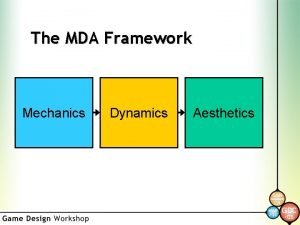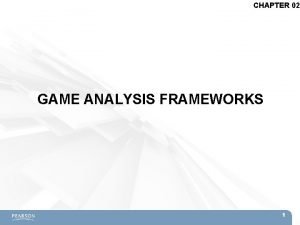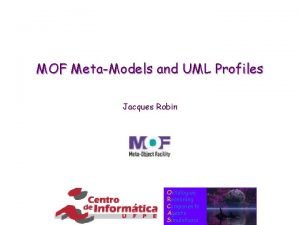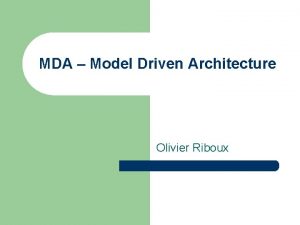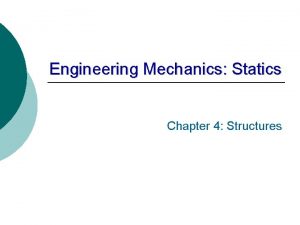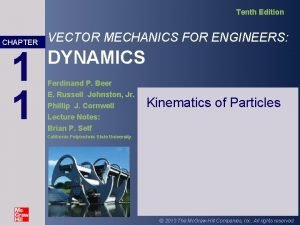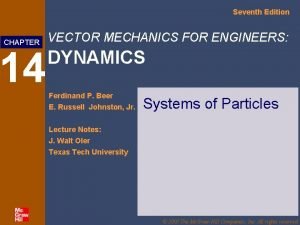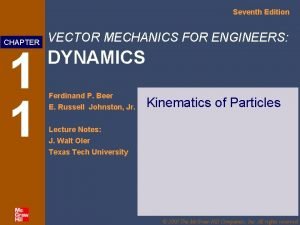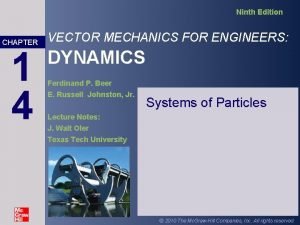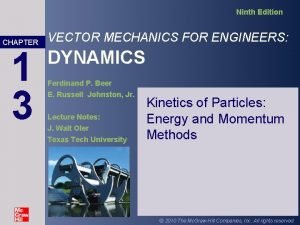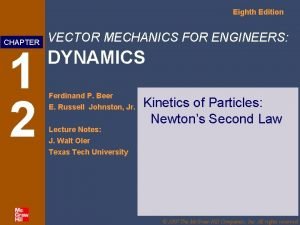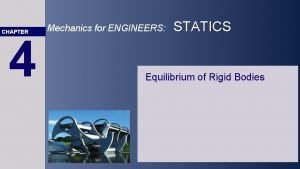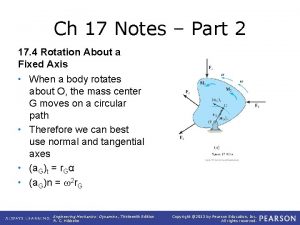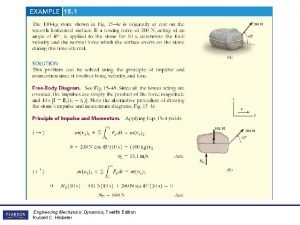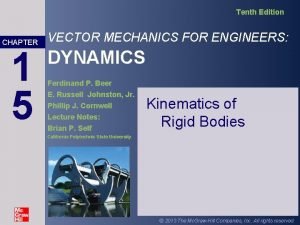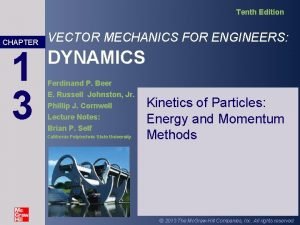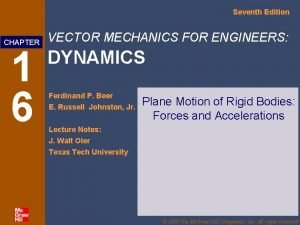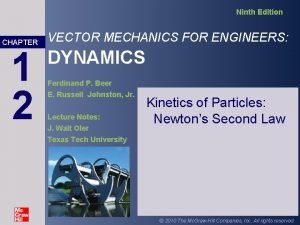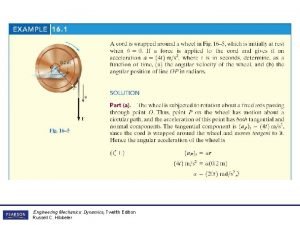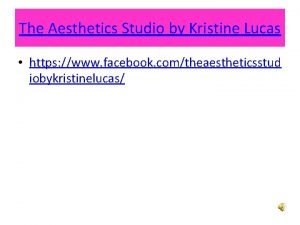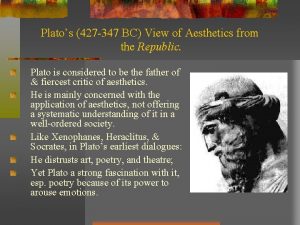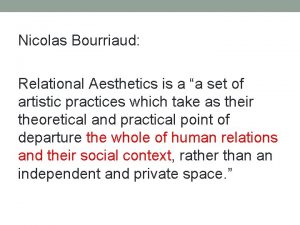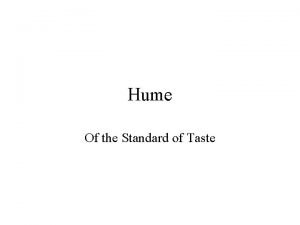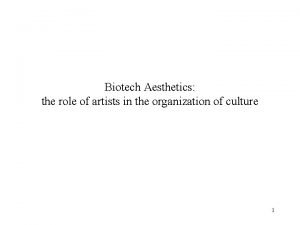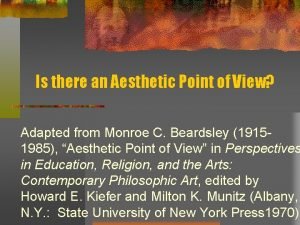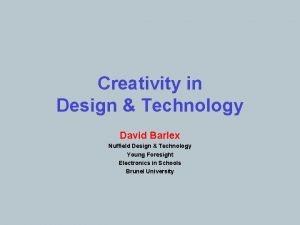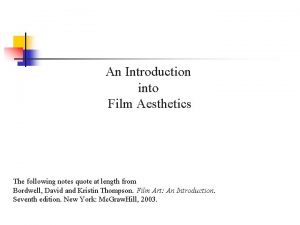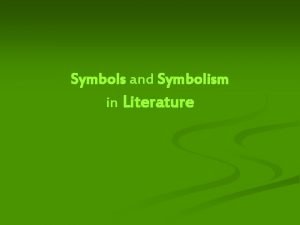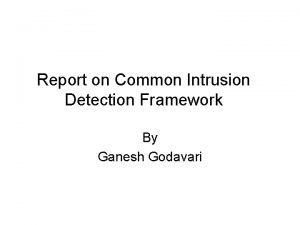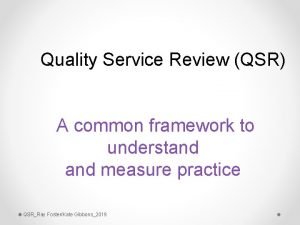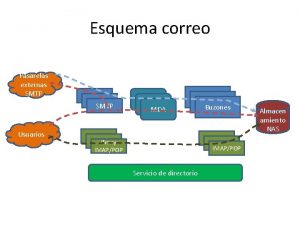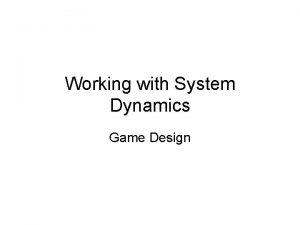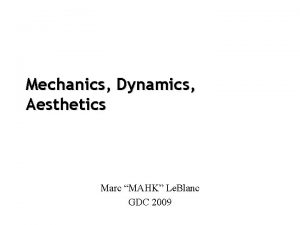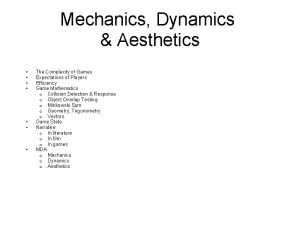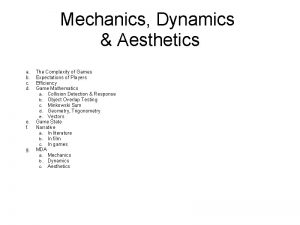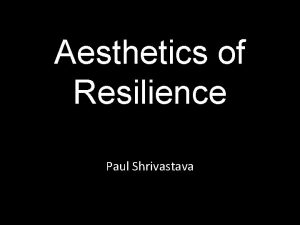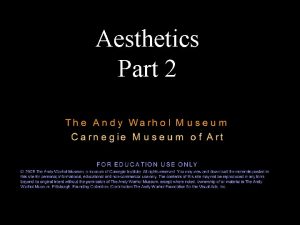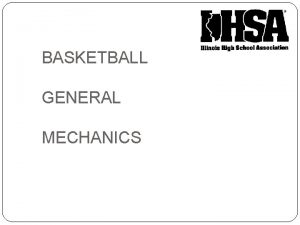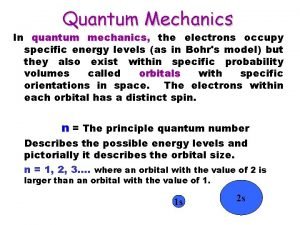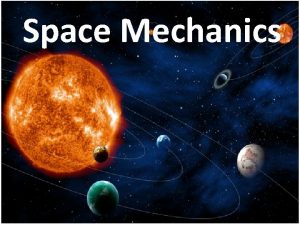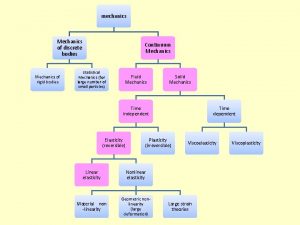The MDA Framework Mechanics Dynamics Aesthetics Some Common
























































































- Slides: 88

The MDA Framework Mechanics Dynamics Aesthetics

Some Common Themes Here are some themes we examined.

Theme: Dynamics and Fantasy • Our game dynamics have meaning within our game’s core fantasy. • That meaning may or may not be compatible. • In order to remain faithful to our subject matter, dynamics and fantasy must be in alignment.

© Steve Jackson Games www. sjgames. com

Theme: State Space and Design Flexibility • The state space of a game is the set of possible states the system can be in. • The larger the state space, the easier it is to make changes. • As we modify our design, we can expect the state space to grow.

Theme: Aesthetic Breadth • Games are not aesthetic laser beams. • Neither are players, neither are designers. • As professionals, we need to be able to match the player’s values as well as our own.

Two Final Thoughts “The intellect is a Bailey bridge built between islands of inspiration. ” - Mike Myers “MDA is like an autopsy. It’s not something you do to your lover. It’s something you do to your ex-lover to find out what went wrong. ” - Frank Lantz

Shameless Plugs • Intution and Intellect: Decontructing the Design of Oasis (thurs, 9 am) • Experimental Gameplay Workshop (thurs, 4 pm)

Links www. 8 kindsoffun. com Marc Le. Blanc mahk@8 kindsoffun. com Andrew Leker aleker@mind-control. com Rob Fermier rfermier@ensemblestudios. com Frank Lantz franklantz@yahoo. com Jonathan Hamel jhamel@breakawaygames. com Steve Librande slibrande@blizzard. com Art Min amin@junctionpoint. com Randy Smith Ronin. Game. Developer. com Tim Stellmach timstellmach@hotmail. com Robin Hunicke hunicke @cs. northwestern. edu

Choices Theme: “Possibilty Space” and Drama Time

Probability is a Valuable Model Chance in 36 This is a model of 2 d 6: Die roll

Game Design and Tuning Workshop Orientation Marc “MAHK” Le. Blanc GDC 2003

Orientation Overview Part I: Workshop Format Part II: Outline Our Formal Approach Part III: Formal Approach in Detail Part IV: Tuning

Part I: Introduction In this part we will: • Explain the workshop high concept. • Describe the format. • Introduce the faculty.

This Workshop Is: • In its third year • Designed to be hands-on. • Focused on the tuning process. • Grounded in a formal approach to game design. • Intended to be open-ended.

This Workshop Isn’t: • About the game “industry. ” • About the game design “profession. ” • Concerned with the early stages of game design. • A one-way street.

What You’ll be Doing • Playing games. • Analyzing games. • Critiquing games. • Modifying games. • Refining games.

A Few Ground Rules • Please attend the whole thing. • Collaborate, Share, and Encourage. • Save the “meta-discussion” for the very end.

Workshop Format • Small-group activities. § Main Exercises (3) § Electives (choose 1 from 3 each day)

Introducing the Faculty • Myself • Rob Fermier • Austin Grossman • Frank Lantz • Andrew Leker • Steve Librande • Katie Salen • Tim Stellmach Also Helping Out: • Art Min • Robin Hunicke

Part II: A Formal Approach In this section, we present • A formal framework for game design. • A view of the designer-player relationship

Game Design “Frameworks” • Paradigms for organizing our understanding.

Game Design “Frameworks” • Paradigms for organizing our understanding. • Example Frameworks: § The 400 Project § Design Patterns

Game Design “Frameworks” • Paradigms for organizing our understanding. • Example Frameworks: § The 400 Project § Design Patterns • Separate from the process.

Our Framework • Organized around the designerplayer relationship. • Grounded in a formal approach.

The Designer-Player Relationship Designer Player

The Designer-Player Relationship Designer Game Player

The Designer-Player Relationship Designer Creates Game Consumes Player

The Designer-Player Relationship Designer Creates Game Book Consumes Player

The Designer-Player Relationship Designer Creates Game Book Movie Consumes Player

The Designer-Player Relationship Designer Creates Game Book Movie Painting Consumes Player

The Designer-Player Relationship Designer Creates Game Book Movie Painting Chair Consumes Player

The Designer-Player Relationship Designer Creates Game Book Movie Painting Chair Car Consumes Player

The Designer-Player Relationship Designer Creates Game Book Movie Painting Chair Car Steak Dinner Consumes Player

The Designer-Player Relationship Creates Game Consumes Designer Player The difference is the way that games are consumed.

An Extreme Opposite Example: A Theatrical Play The “design team” knows: • Script • Lighting • Acoustics • Seating • Intermissions

Games, on the Contrary The designer doesn’t know: • When will the player play? How often? For how long? • Where? With Whom? And most importantly. . . • What will happen during the game?

Obligatory Editorial This lack of predictability is the essence of play. It should be embraced, not eschewed.

A Formal Model of “Game Consumption” Rules System Behavior “Fun”

The Player-Designer Relationship, Revisited Designer Rules System Behavior “Fun” Player

The MDA Framework Mechanics Dynamics Aesthetics

Definitions • Mechanics: The rules and concepts that formally specify the game-assystem.

Definitions • Mechanics: The rules and concepts that formally specify the game-assystem. • Dynamics: The run-time behavior of the game-as-system.

Definitions • Mechanics: The rules and concepts that formally specify the game-assystem. • Dynamics: The run-time behavior of the game-as-system. • Aesthetics: The desirable emotional responses evoked by the game dynamics.

The Building Blocks: Formal Models • No Grand Unified Theory • Instead, lots of little models • Models can be formulas or abstractions. • We can think of models as “lenses. ” • Discovering new models is an ongoing process.

MDA is a “Taxonomy” for Models • Knowledge of Aesthetics • Knowledge of Dynamics • Knowledge of Mechanics • Knowledge of the interactions between them.

Properties of Good Models We want our models to be: • Formal (i. e. well-defined). • Abstract (i. e. widely applicable). • Proven (i. e. known to work). On any given game, we expect to use several different abstractions, not one big one.

Part III: MDA in detail In this part, we discuss Aesthetics, Dynamics and Mechanics in detail.

The Player’s Perspective Mechanics Dynamics Aesthetics

The Designer’s Perspective Mechanics Dynamics Aesthetics

Understanding Aesthetics We need to get past words like “fun” and “gameplay. ” • What kinds of “fun” are there? • How will we know a particular kind of “fun” when we see it?

Eight Kinds of “Fun”

Eight Kinds of "Fun" 1. Sensation Game as sense-pleasure

Eight Kinds of "Fun" 1. Sensation Game as sense-pleasure 2. Fantasy Game as make-believe

Eight Kinds of "Fun" 1. Sensation Game as sense-pleasure 2. Fantasy Game as make-believe 3. Narrative Game as drama

Eight Kinds of "Fun" 1. Sensation Game as sense-pleasure 2. Fantasy Game as make-believe 3. Narrative Game as drama 4. Challenge Game as obstacle course

Eight Kinds of "Fun" 1. Sensation Game as sense-pleasure 2. Fantasy Game as make-believe 3. Narrative Game as drama 4. Challenge Game as obstacle course 5. Fellowship Game as social framework

Eight Kinds of "Fun" 1. Sensation Game as sense-pleasure 2. Fantasy Game as make-believe 3. Narrative Game as drama 4. Challenge Game as obstacle course 5. Fellowship Game as social framework 6. Discovery Game as uncharted territory

Eight Kinds of "Fun" 1. Sensation Game as sense-pleasure 2. Fantasy Game as make-believe 3. Narrative Game as drama 4. Challenge Game as obstacle course 5. Fellowship Game as social framework 6. Discovery Game as uncharted territory 7. Expression Game as self-discovery

Eight Kinds of "Fun" 1. Sensation Game as sense-pleasure 2. Fantasy Game as make-believe 3. Narrative Game as drama 4. Challenge Game as obstacle course 5. Fellowship Game as social framework 6. Discovery Game as uncharted territory 7. Expression Game as self-discovery 8. Masochism Game as submission

Clarifying Our Aesthetics • Charades is “fun. ” • Quake is “fun. ” • Final Fantasy is “fun. ”

Clarifying Our Aesthetics • Charades: Fellowship, Expression, Challenge • Quake: Challenge, Sensation, Competition, Fantasy • Final Fantasy: Fantasy, Narrative, Expression, Discovery, Challenge, Masochism • Each game pursues multiple

Clarifying Our Goals • As designers, we can choose certain aesthetics as goals for our game design. • We need more than a one-word definition of our goals.

What is an “Aesthetic Model? ” • A rigorous definition of an aesthetic goal. • Serves as an “aesthetic compass. ” • States criteria for success as well as possible modes of failure. Some examples…

Goal: Competition Model: A game is competitive if: • Players are adversaries. • Players have an ongoing emotional investment in defeating each other. Some Failure Modes: • A player feels that he can’t win. • A player can’t measure his progress.

Goal: Realistic Flight Simulation Possible Models: Our flight dynamics are realistic if: • They match a mathematical formula, or, • They pass our “realism checklist, ” Failure Modes: • Counter-intuitive system behavior.

Goal: Drama Model: A game is dramatic if: • Its central conflict creates dramatic tension. • The dramatic tension builds towards a climax.

Goal: Drama Failure Modes: • Lack of conflict. • Lack of tension. § The conflict’s outcome is obvious (no uncertainty). § No sense of forward progress (no inevitability). • Tension does not increase towards a climax. On to Dynamics. . .

Understanding Dynamics • How can we predict and explain the behavior of the game-assystem?

Formalizing Game Dynamics Input (Player) Rules Output State (Graphics/ Sound) The “State Machine” Model Examples: Chess, Quake

Models of Game Dynamics • Again, no Grand Unified Theory • Instead, a collection of many Dynamic Models. • Dynamics models are analytical in nature. Some examples…

Example: Random Variable Chance in 36 This is a model of 2 d 6: Die roll

Example: Feedback System A feedback system monitors and regulates its own state. Room Thermometer Heater Too Cold Too Hot Cooler Controller An Ideal Thermostat

Example: Operant Conditioning • The player is part of the system, too! • Psychology gives us models to explain and predict the player’s behavior.

Where Models Come From • Analysis of existing games. • Other Fields: Math, Psychology, Engineering… • Our own experience. On to Mechanics. . .

Understanding Mechanics • There’s a vast library of common game mechanics.

Examples • Cards: Shuffling, Trick-Taking, Bidding • Shooters: Ammunition, Spawn Points • Golf: Sand Traps, Water Hazards

Mechanics vs. Dynamics We need to acknowledge mechanics and dynamics as distinct concepts. Dynamics emerge from Mechanics.

Interaction Models • How do specific dynamics emerge from specific mechanics? • How do specific dynamics evoke specific aesthetics?

Example: Time Pressure • “Time pressure” is a dynamic. • It can create dramatic tension. • Various mechanics create time pressure: § Simple time limit § “Pace” monster § Depleting resource

Moving Forward… Let’s hope the future brings us: • A rich aesthetic vocabulary. • A eclectic library of game mechanics. • A catalog of formal models: Aesthetic, Dynamic, Interaction In other words, “Formal Abstract Design Tools. ”

Part IV: Tuning In this part we will: • Define tuning. • Present a formal approach.

What we mean by “Tuning: ” Analyze Test Revise Tuning is an iterative process.

We’re not limited to: • Parameter tweaking • “Fiddling with knobs”

MDA in the Tuning Process Aesthetic Models help us: • • • Articulate our goals. Point our game’s flaws. Measure our progress. Dynamic Models help us: • Pinpoint our problems. Both kinds help us: • Evaluate possible revisions.

Learning From the Tuning Process Between iterations, we re-evaluate: • Our goals. • Our models • Our assumptions. Sometimes we need to revise our own thinking as well.

The Tuning Process Before we start: • Know our aesthetic goals. While we iterate: • Aesthetic and dynamics models guide our way. Between Iterations • Learn from the process.

Time for Coffee. . . After the break, go to the classroom that matches the color of your poker chip: Blue Red White C 1 C 2 C 3
 Mda dynamics
Mda dynamics Mechanics dynamics aesthetics
Mechanics dynamics aesthetics Disking teeth
Disking teeth Visão do mda
Visão do mda Smr staging males
Smr staging males Mda montauban
Mda montauban Mda analysis games
Mda analysis games Mda uml
Mda uml Uml2.0
Uml2.0 Omg mda
Omg mda Discipulado mda
Discipulado mda Chapter 4 statics
Chapter 4 statics Vector mechanics for engineers: dynamics
Vector mechanics for engineers: dynamics Vector mechanics for engineers: dynamics
Vector mechanics for engineers: dynamics Vector mechanics for engineers: dynamics
Vector mechanics for engineers: dynamics Vector mechanics for engineers: dynamics
Vector mechanics for engineers: dynamics Vector mechanics for engineers: dynamics
Vector mechanics for engineers: dynamics Vector mechanics for engineers: dynamics
Vector mechanics for engineers: dynamics Engineering mechanics: dynamics chapter 4
Engineering mechanics: dynamics chapter 4 Hibbeler dynamics
Hibbeler dynamics Mechanics
Mechanics At the instant shown the length of the boom ab
At the instant shown the length of the boom ab Vector mechanics for engineers dynamics 12th
Vector mechanics for engineers dynamics 12th Vector mechanics for engineers dynamics 12th
Vector mechanics for engineers dynamics 12th Vector mechanics for engineers dynamics 12th
Vector mechanics for engineers dynamics 12th Engineering mechanics
Engineering mechanics Law of similarity in psychology
Law of similarity in psychology Racquel aesthetics
Racquel aesthetics The elements of aesthetics are
The elements of aesthetics are The concept of aesthetics
The concept of aesthetics The aesthetics studio
The aesthetics studio Plato aesthetics
Plato aesthetics Bourriaud relational aesthetics
Bourriaud relational aesthetics Transcendental aesthetic
Transcendental aesthetic Beast and beauty aesthetics
Beast and beauty aesthetics Example of environmental aesthetics
Example of environmental aesthetics Aesthetics in photography
Aesthetics in photography Hegel philosophy of fine art summary
Hegel philosophy of fine art summary Hume aesthetics
Hume aesthetics Biotechnology aesthetics
Biotechnology aesthetics Introduction to aesthetics
Introduction to aesthetics Applied media aesthetics
Applied media aesthetics Aesthetic point
Aesthetic point Aesthetics developers
Aesthetics developers Nuffield design and technology
Nuffield design and technology Film aesthetics
Film aesthetics Gk aesthetics
Gk aesthetics Banobagi doctors
Banobagi doctors They say sometimes you win some
They say sometimes you win some Sometimes you win some sometimes you lose some
Sometimes you win some sometimes you lose some Ice cream: countable or uncountable
Ice cream: countable or uncountable What are some contact forces and some noncontact forces
What are some contact forces and some noncontact forces Some say the world will end in fire some say in ice
Some say the world will end in fire some say in ice Some say the world will end in fire some say in ice
Some say the world will end in fire some say in ice Some trust in horses
Some trust in horses Ctip for acquisition and contracting professionals
Ctip for acquisition and contracting professionals Symbolism in literature
Symbolism in literature What is the greatest common factor of 12 and 42
What is the greatest common factor of 12 and 42 Common anode and common cathode
Common anode and common cathode 56 prime factorization
56 prime factorization Highest common factors and lowest common multiples
Highest common factors and lowest common multiples Factors of 12 and 42
Factors of 12 and 42 Highest common factors and lowest common multiples
Highest common factors and lowest common multiples Common intrusion detection framework
Common intrusion detection framework Common security advisory framework
Common security advisory framework Caf model
Caf model Common assessment framework 2020
Common assessment framework 2020 Umbrella activities in software engineering
Umbrella activities in software engineering It provides a common framework to allow data to be shared
It provides a common framework to allow data to be shared Common framework
Common framework Dispositional framework vs regulatory framework
Dispositional framework vs regulatory framework Theoretical framework vs conceptual framework
Theoretical framework vs conceptual framework Theoretical framework example
Theoretical framework example Conceptual framework theoretical framework
Conceptual framework theoretical framework Dispositional framework vs regulatory framework
Dispositional framework vs regulatory framework Theoretical framework example
Theoretical framework example Hình ảnh bộ gõ cơ thể búng tay
Hình ảnh bộ gõ cơ thể búng tay Ng-html
Ng-html Bổ thể
Bổ thể Tỉ lệ cơ thể trẻ em
Tỉ lệ cơ thể trẻ em Chó sói
Chó sói Chụp phim tư thế worms-breton
Chụp phim tư thế worms-breton Chúa yêu trần thế
Chúa yêu trần thế Các môn thể thao bắt đầu bằng tiếng chạy
Các môn thể thao bắt đầu bằng tiếng chạy Thế nào là hệ số cao nhất
Thế nào là hệ số cao nhất Các châu lục và đại dương trên thế giới
Các châu lục và đại dương trên thế giới Công thức tính thế năng
Công thức tính thế năng Trời xanh đây là của chúng ta thể thơ
Trời xanh đây là của chúng ta thể thơ Cách giải mật thư tọa độ
Cách giải mật thư tọa độ
